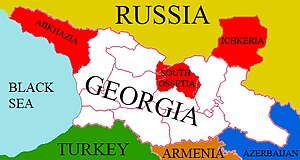The War in Abkhazia in 1998 took place in the Gali district of Abkhazia, after ethnic Georgians launched an insurgency against the Abkhazian separatist government. The conflict is sometimes referred to as the Six-Day War of Abkhazia; however, this name only takes into account the Abkhazian offensive that lasted from 20 to 26 May 1998, while hostilities and insurgent attacks had already occurred before that date.[6][4]
| War in Abkhazia (1998) | |||||||
|---|---|---|---|---|---|---|---|
| Part of the Georgian–Abkhazian conflict | |||||||
 | |||||||
| |||||||
| Belligerents | |||||||
|
|
| ||||||
| Commanders and leaders | |||||||
|
|
| ||||||
| Strength | |||||||
| 1,500 troops[2] | 400 guerrillas[citation needed] | ||||||
| Casualties and losses | |||||||
|
Abkhazia:[3] 8 killed 17 wounded Georgian sources:[4] 300+ killed dozens wounded |
Georgian sources:[4] 17 killed 24 wounded 56 captured 6 missing Abkhazia:[3] 160 killed | ||||||
|
35 Georgian civilians killed 30,000–40,000 displaced[5] | |||||||
Timeline
editIn the eighteen months prior to the war, Georgian paramilitary forces systematically attacked both Russian peacekeeping troops and the Abkhazian military.[7]
In the beginning of May, 300 fighters from the Georgian paramilitary White Legion crossed into Abkhazia, whereupon the Abkhazian government placed its military on combat alert.[8] The White Legion was said to have received orders from Tamaz Nadareishvili, head of Georgia's government in exile for Abkhazia and member of Georgia's Security Council.[5] In addition, Tornike Berishvili, a leader of the Mkhedrioni, declared on 27 May that 100 of its men had also fought in Abkhazia.[1] According to Georgian sources, on 2 and 3 May Georgian forces gained control of the villages of Saberio, near the Inguri Dam, and Khumushkuri, and killed six Abkhazian soldiers when Abkhazian forces tried to retake the two villages.[9] On 12 May, Georgian MP Germane Patsatsia announced that he was resigning to join the Georgian guerillas in Abkhazia who he claimed had seized control of Gali District.[10]
On 18 May, Georgian forces killed about twenty Abkhazian policemen in a surprise attack in the village of Repi.[11][5] The next day, Abkhazian troops carried out reprisal attacks, resulting in ten to thirty deaths and causing Georgian residents to flee across the border.[12] The following days saw minor, sporadic clashes as the Abkhazian Interior Ministry sent 800 more men into Gali District. Abkhazian forces were reported to set fire to Georgian homes.[13]
On 22 May, the two sides signed a cease-fire agreement in Tbilisi, which was broken that same day when fighting broke out in the village of Tskhiri, killing four people. The next three days saw fierce fighting, with ITAR-TASS reporting the death of 40 Abkhazian soldiers, 4 Georgian soldiers and more than 20 Georgian civilians.[14]
On 25 May, the Georgian and Abkhazian foreign ministers signed another cease-fire agreement in Gagra, set to take effect at 6:00 the following day, but fighting continued.[15] On the night of 26 to 27 May, Abkhazian forces expelled the last Georgian guerillas.[16]
Georgia's opposition blamed President Eduard Shevardnadze for losing the war by not supporting the guerillas with the Georgian Military.[17] Shevardnadze declared that one of the reasons he had not sent in the military was it was not combat-ready.[18]
Further reading
edit- Aaron Belkin, United We Stand?; Divide-and-Conquer Politics and the Logic of International Hostility State University of New York Press, 2005.
References
edit- ^ a b Fuller, Liz (28 May 1998). "Controversial Georgian Paramilitary Organization Still Active". Newsline. Radio Free Europe/Radio Liberty. Retrieved 4 August 2016.
- ^ Bahcheli, Tozun (2004). De Facto States: The Quest For Sovereignty. Psychology Press. p. 151. ISBN 9780203485767.
- ^ a b "Okopka.ru: Татарченков Олег Николаевич. Рикошет (записки военного корреспондента)". okopka.ru.
- ^ a b c "Archived copy" (PDF). Archived from the original (PDF) on 2009-03-26. Retrieved 2007-09-27.
{{cite web}}: CS1 maint: archived copy as title (link) - ^ a b c Fuller, Liz (28 May 1998). "Abkhaz offensive ruins peace prospects". Newsline. Radio Free Europe/Radio Liberty. Retrieved 4 August 2016.
- ^ Cheterian, Vicken (December 1, 1998). "Ethnic conflict in Georgia". Le Monde diplomatique.
- ^ Fuller, Liz (21 April 1998). "Loose Cannons in Abkhazia". Caucasus Report. Vol. 1, no. 8. Radio Free Europe/Radio Liberty. Retrieved 4 August 2016.
- ^ Fuller, Liz (11 May 1998). "Georgia to become 'asymmetric federation?'". Newsline. Radio Free Europe/Radio Liberty. Retrieved 4 August 2016.
- ^ "Have Georgian guerrillas seized ground in Abkhazia". Monitor. Vol. 4, no. 85. Jamestown Foundation. 4 May 1998.
- ^ Fuller, Liz (13 May 1998). "Georgian Parliamentary Deputy Quits to Join Guerrillas". Newsline. Radio Free Europe/Radio Liberty. Retrieved 4 August 2016.
- ^ Fuller, Liz (19 May 1998). "More guerrilla clashes in Abkhazia". Newsline. Radio Free Europe/Radio Liberty. Retrieved 4 August 2016.
- ^ Fuller, Liz (21 May 1998). "Georgians flee as Abkhaz fighting intensifies". Newsline. Radio Free Europe/Radio Liberty. Retrieved 4 August 2016.
- ^ Fuller, Liz (22 May 1998). "Situation on Georgian-Abkhaz border remains tense". Newsline. Radio Free Europe/Radio Liberty. Retrieved 4 August 2016.
- ^ Fuller, Liz (25 May 1998). "Abkhaz fighting continues..." Newsline. Radio Free Europe/Radio Liberty. Retrieved 4 August 2016.
- ^ Fuller, Liz (26 May 1998). "Abkhaz fighting continues, despite cease-fire agreement". Newsline. Radio Free Europe/Radio Liberty. Retrieved 4 August 2016.
- ^ Fuller, Liz (27 May 1998). "Abkhaz Expel Georgian Guerrillas From Gali". Newsline. Radio Free Europe/Radio Liberty. Retrieved 4 August 2016.
- ^ Fuller, Liz (29 May 1998). "Georgian Opposition Blames Shevardnadze for Defeat". Newsline. Radio Free Europe/Radio Liberty. Retrieved 4 August 2016.
- ^ Fuller, Liz (3 June 1998). "Georgian Army "Not Combat-ready"". Newsline. Radio Free Europe/Radio Liberty. Retrieved 4 August 2016.